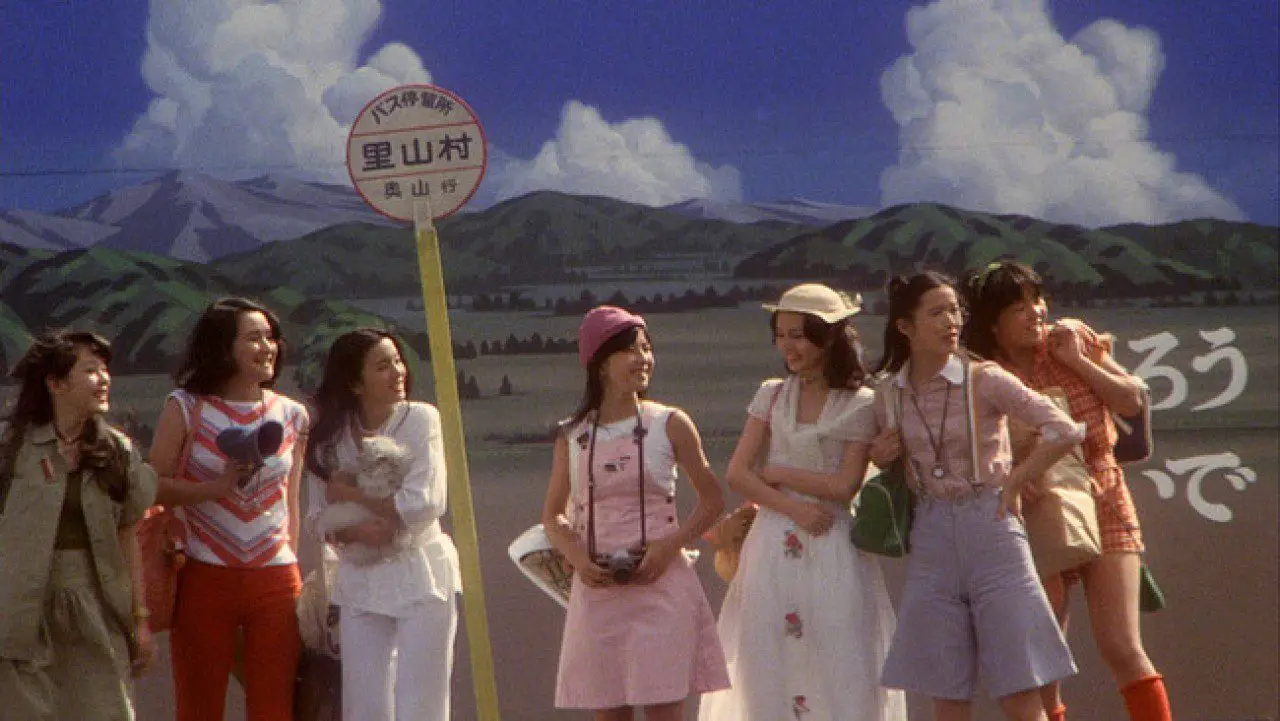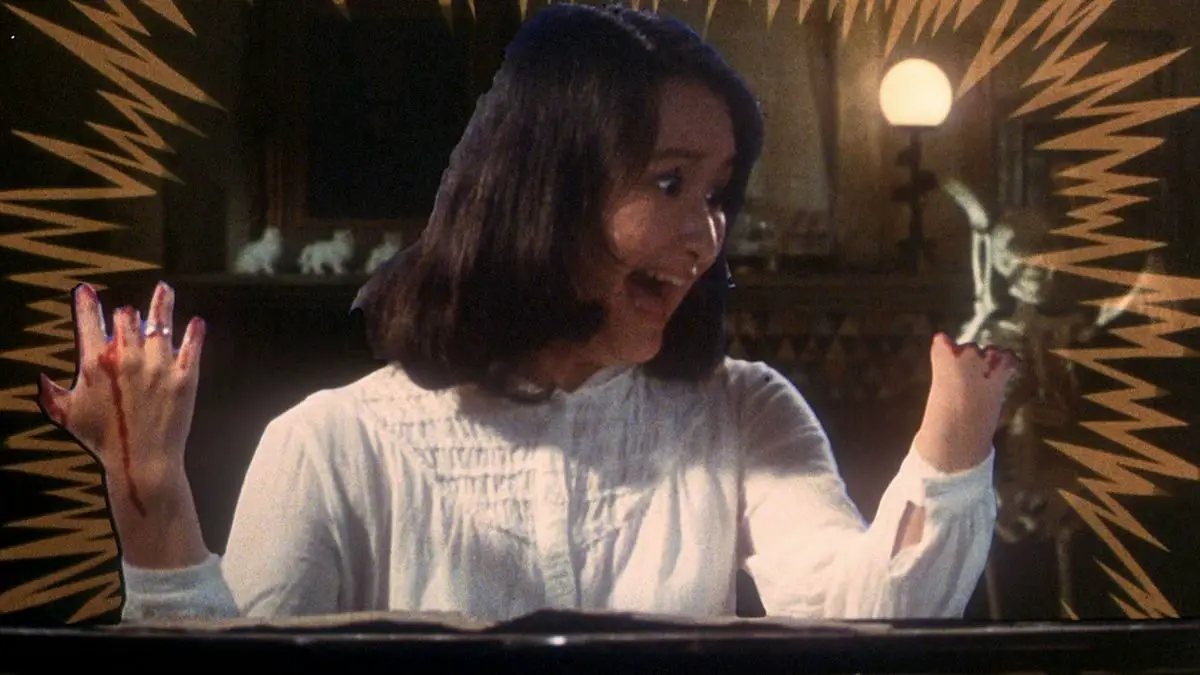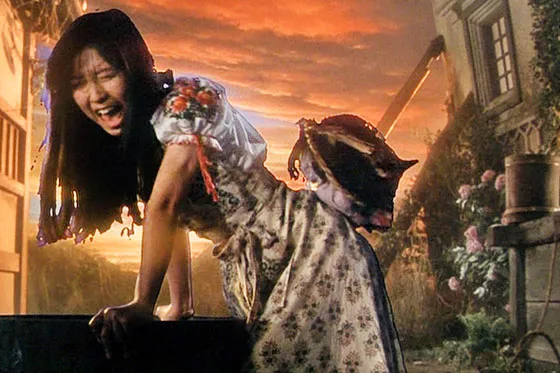The history behind Nobuhiko Obayashi’s 1977 House is as fascinating as the movie itself. Toho, desperate for a hit, asked the young director, who had only done commercials at the time, for “something like Jaws.” The result is as far away from the Speilberg blockbuster as you could imagine but also became a megahit amongst the kids of the time.
To call Obayashi’s House strange or weird is an understatement. Often lumped in with J-horror movies, House is more of a comedic fantasy rather than an eerie bone-chilling tale. Yet there are moments of gore and other inexplicable occurrences. Visually overwhelming, it can be tempting to write House off as a surreal masterpiece about “nothing.”

But this is only because House can be such a sensory overload that it can be easy to miss the blatant text of the film. Far from subtle, House wrestles with a barrage of themes from the bomb to girls on the cusp of womanhood. Dismissing it as merely style over substance misses the point of art and of House.
Obayashi’s goal was to turn “experimentation into expression.” House represents cinema in its purest form. “The power of cinema isn’t in the explainable but in the strange and inexplicable.” A notion that would baffle most plotcels that make up modern audiences.
Describing the plot of House is not only a fool’s errand but also missing the point. The story is as basic as they come, and that’s by design. Co-written by Obayashi, Chiho Katsura, with the help of Obayashi’s eleven-year-old daughter Chigumi, House is a haunted house story in name only.
The seven girls don’t even have names so much as tropes. The main girl is Gorgeous (Kimiko Ikegami), followed by the tomboyish Kung-Fu (Miki Jinbo), the bookish Professor, known as Prof (Ai Matsubara), the girl with her head in the clouds Fantasy (Kumiko Oba), the musical Melody (Eriko Tanaka), the demure Sweet (Masayo Miyako), and the always hungry Mac (Mieko Sato). Visually distinctive characteristics define seven girls: Prof wears glasses, Mac always eats, and so on, allowing us to keep them visually distinct amidst all the chaos that will unfold.
Obayashi makes every scene an orgiastic feast for the eyes, to the point that it can be exhausting if you are unprepared. Most movies lose steam, but Obayashi and his tireless cinematographer Yoshitaka Sakamoto only seem to pick up steam as the movie zips along. House demands your attention as it hopscotches between tones and moods without pausing for a breath.
“Adults can only think about things they understand, so everything stays on that boring human level.” Being from commercials and using his daughter’s ideas, Obayashi makes every frame of House pop art. Still, far from being vapid, they erupt with a playfulness underlined with heartbreaking confusion as the girls struggle with their emotions and the horrors of the house.
The house is owned by Gorgeous’s Aunt, Auntie (Yoko Minamida), who welcomes her niece with perhaps too open arms. Gorgeous is trying to run away as her father, Father (Saho Sasazawa), has brought home a fiancée, a new mother for Gorgeous.
Throughout House, Obayashi and Katsura have multiple instances of characters discussing arranged marriages and crushes, showcasing how attitudes and norms have changed. In many ways, House embodies the line from Magnolia: “You may be done with the past, but the past is not done with you.”
Especially when it is quickly revealed that Auntie is either a vampire or, at the very least, vampiric, or the house is. Either way, the girls rapidly begin being devoured or absorbed by the house. Yet, it’s never horrifying; with dancing skeletons and Auntie winking at the camera, House never drops its impish demeanor.

Woven throughout all this is the remnants of the Hiroshima bomb. From the way Sakamoto and editor Nobuo Ogawa utilize flashes of light to symbolize the bomb or how Obayashi shows actual footage of the explosions with the girls saying, “Ooooh, it looks like cotton candy.” The horrors of the past give way to the pleasures of the present, but the consequences, like fingerprints, remain with them, psychologically.
Another way House looks at this is how the girls comment about masculinity. Fantasy dreamily crushes on Mr. Togo (Kiyohiko Ozaki), a klutzy laid back teacher while the other girls swoon over a flashback of Auntie’s doomed fiancé, played by Tomokazu Miura, a stoic, square-jawed doctor killed in the war. Times change, attitudes change, and that’s not a bad thing.
It’s easy to dismiss House as surrealist nonsense. Indeed, many people who worked on the film admittedly had a good time but told Obayashi that the film was terrible. But doing so misses the larger point of what Obayashi is doing; besides utilizing every filmmaking trick in the book and playing with special effects, he’s also plumbing the psyche of his generation while celebrating his daughter’s generation and the very real clashes that stem from that.
There’s also the possibility of how the latent Queerness of House might make some people uneasy. The straights have never been okay, but never more so when there’s queerness in their art. Whether it’s the way Fantasy and Gorgeous hold each other or how in awe the girls are of Kung Fu as she struts around with utter fearlessness, there’s a subtext to House that is hardly subtle.
The most infamous scene is the one with the disembodied head of Mac bites Fantasy in the keister. You’ve probably seen the gifs, but what is often forgotten is that immediately afterward, Mac rubs herself on Fantasy’s butt, giggling manically. You could handwave this scene away and say it’s simply a macabre joke about Mac always eating, but the act of how happy she is rubbing herself on Fantasy shows it for something else.

Part of what might make the Queerness in House so discomforting for some is how it’s there beneath the surface. Obayashi never addresses it. More likely than not, Obayashi may not have intended for it to be there, but it is there all the same.
Much of House deals with buried and repressed emotions threatening to explode. Much like horror, which deals with repression and suppressed desires, House looks at how society can suffocate and harm with its notions of taboos and social norms. Combined with how the girls are teenagers, unsure of how to process the changing world and themselves.
House is a breathless paradox. Obayashi, a commercial director in awe of Japanese cinema, made a film inspired by the West, even to the point that the Japanese film has an English title, House. Oh, there are Japanese elements, the white cat Blanche, for instance. Strange cats, known as Kaibyo, are staples of Japanese folklore. One of the girls even calls Blanche a “witch’s cat.” The paradox makes House compelling for several reasons, but most of all, the result is so unique that it can hardly be called neither Western nor Eastern but merely Obayashi.
Asei Kobayashi’s score contributes to this. With a relentlessly upbeat melodic synth score that shifts into day-glo pop-rock’ n’ roll and back again, House’s soundtrack is as unique and staggering as the film itself. Kobayashi was a long-time collaborator of Obayashi’s from his commercial days. Upon getting his big break, he gave a job to Kobayashi, who, after writing a few piano pieces, confided that he was too old for what the film needed. He suggested a rock band, Godiego.
The music in House enhances the already dangerous sensory overload of every scene. Highlighting the melodrama in some while clashing with the images in another, Godiego and Kobayashi’s rise to the occasion. I can’t imagine the daunting task of creating a soundtrack that fits a scene of a piano eating a young girl.
House is a rare film in that it is made up of whole cloth. You may have seen other movies referenced or inspired by House. But you have never seen anything like House. It exists on its own plane of existence, defies you to come along for the ride, and leaves you breathless and exhausted from its sheer creativity and vitality.
Images courtesy of Toho
Have strong thoughts about this piece you need to share? Or maybe there’s something else on your mind you’re wanting to talk about with fellow Fandomentals? Head on over to our Community server to join in the conversation!

